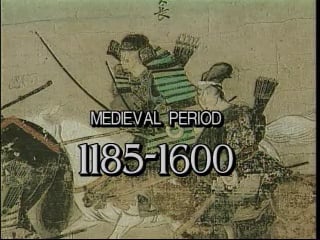Playlist: Introduction to Medieval Japan
A Time of War: Parallels with Feudal Europe
The conventional dates for the Medieval Period in Japan are 1185 to 1600. 1185 marks the end of the Gempei War (1180-1185; also written as "Genpei") and the beginning of military rule; 1600 marks the unification of Japan under the Tokugawa shogunates and the beginning of the Tokugawa period (1600-1868).
Transcript
Robert Oxnam: Medieval Japan, the long period from the thirteenth century to the early seventeenth century, conjures up parallels with feudal Europe. After all, both Japan and Europe were caught up in intense fighting spearheaded by warrior classes. In fact, the Japanese samurai does have some similarities to the European knight. And political power was divided into feudal subunits, although the structures in Japan were significantly different from those in the West.
There's another similarity as well. In Japan, as in Europe, constant warfare caused people to seek solace in religion. The Buddhist faith, which emphasized the impermanence of life, spread from its former hold among aristocrats to have a new appeal throughout Japanese society. Buddhism touched everything in life, but its poignancy is perhaps greatest in Japanese literature.
[Opening lines of The Tale of the Heike, compiled in the 14th C.]In the sound of the bell of the Gion temple echoes the impermanence of all things. ... The proud ones do not last long, but vanish like a spring night's dream. And the mighty ones, too, will perish like dust before the wind.
[Excerpt from An Account of My Hut, written in 1212 by Kamo no Chōmei]
... The flow of the river is ceaseless and its water is never the same. The bubbles that float in the pools, now vanishing, now forming, are not of long duration. So in the world are man and his dwellings.
H. Paul Varley: We move from an age in which the rulers were courtiers serving the emperor at his court in Kyoto, to an age in which rough warriors from the provinces emerge as the new rulers of the land.
The Tale of the Heike, translation of opening lines provided by H. Paul Varley, University of Hawai'i. For a complete translation see The Tale of the Heike, Hiroshi Kitagawa and Bruce T. Tsuchida, trans. (Tokyo: University of Tokyo Press, 1975).
An Account of My Hut, by Kamo no Chōmei, from Anthology of Japanese Literature: From the Earliest Era to the Mid-Nineteenth Century, Donald Keene, ed. (New York: Grove Press, 1960), p. 197.
“Feudalism” in Japan
Transcript
Robert Oxnam: The term "feudal era" has often been used to describe the Japanese medieval period. Historians have been fascinated by the similarities, and by the differences, between Japanese and European feudalism.
H. Paul Varley: When Japan entered the modern age and learned about Western history and Western historians began to study Japan, people were struck by the fact of what appeared to be great parallels between this kind of feudalism in Europe and in Japan. And as the comparative study developed, people went so far as to say that the kind of feudalism that we are talking about existed in only two places, at two times, in world history, and that was Europe, western Europe, during its medieval period, and Japan during its medieval period.
The problem however with this is that Western feudalism was taken as the model and people looked at Japanese history and sought to find things that were comparable to the Western model. And that brought about, inevitably, a certain distortion of the Japanese case. Japan was made to fit the Western model. And in recent years both Japanese historians, and perhaps particularly Western historians, have begun to rebel against the whole business of comparative feudalism with the particular desire, Western historians of Japan particularly, a particular desire to see and understand Japan on its own terms. That having been said, there still are remarkable similarities.
Now, stated in simple terms, what we mean by this kind of feudalism is, we have the premise of a society that is overwhelmingly agricultural; there's very little commercial development. Most of the people are peasants, they're serfs tied to the land, and you have a ruling military or warrior class. And the two most critical elements in that warrior class are the lord-vassal relationship and the fiefholding.
Kinship Aspect of the Lord-Vassal Relationship
Transcript
Robert Oxnam: Much attention has centered on the lord-vassal relationship.
H. Paul Varley: One aspect of the warrior way, the lord-vassal relationship in Japan, that sets it apart quite distinctively from Europe, is that the Japanese tended to conceive of this relationship in kinship terms, or fictive kinship terms.
Now, we see the development of warrior bands from the beginnings of warrior society in the late ninth and tenth centuries. Originally or initially the beginning of these bands comprised warriors who were related by blood. In other words, they were families or family groupings. But later on, a people who were not akin were brought into the warrior bands. And then the lord-vassal relationship included both kin and non-kin, and yet, there was always this tendency to conceive of it in fictive kinship terms. To see the lord as the parent and the vassals as the children. We can see this actually throughout Japanese history and even today.
The War Tales of the Samurai
Transcript
H. Paul Varley: Now, what kind of soldiers or what kind of warriors were the Japanese warriors who brought the country into feudalism? Warriors, of course, are called samurai — that's the term that we know.
The best source, the richest source of knowledge about warriors in this ancient age and also in early medieval times, beginning in the late twelfth century, is a genre of literature called the war tales. These war tales are mixtures of fact and fiction, but they tell us in very vivid, detailed, graphic terms the behavior of these warriors. We see them on their horses in their battles. We see them esteeming honor, seeking fame, concerned about face, literally alarmed at the prospect they might be subjected to shame.
[Excerpt from The Tale of the Heike, compiled in the 14th C.]Seeing that his father was in danger... Kanetsuna... came to his aid. He galloped back and forth, fighting desperately so that his father would be able to retire in peace... Now as he fought an arrow from the bow of the Captain of the Imperial Guard... grazed the edge of his helmet and struck him in the forehead. As Kanetsuna staggered from this, Jiro-maru... whipped his horse toward him. As they passed each other, they grappled and fell heavily to the ground. The wound inside Kanetsuna's helmet was deep, but he was a man of great strength. He seized young Jiro-maru... and struck off his head. Kanetsuna rose to his feet, but fourteen or fifteen mounted soldiers...fell upon him, and finally he was slain.
Excerpt from The Tale of the Heike, Hiroshi Kitagawa and Bruce T. Tsuchida, trans. (Tokyo: University of Tokyo Press, 1975), pp. 270-271.
Seeking Solace in Religion: The Spread of Buddhism
Transcript
Robert Oxnam: Also interesting is a comparison of Japanese Buddhism and Western Christianity, both of which spread rapidly in feudal societies. It's intriguing to think about the sharp differences in the two theological outlooks, but also about some similarities in their respective impacts on social and cultural life.
Donald Keene: Of course, Buddhism didn't begin in the medieval period. The Japanese first became acquainted with Buddhism at the end of the sixth century. And after some struggle with the believers in Shintō, the two religions came to co-exist, and most Japanese believed in both of them at the same time. What is important in the medieval period is that Buddhism — which up until this time had been a religious discipline started mainly by priests, monks in monasteries, or else by people who were scholars — became the religion of many ignorant people who turned to religion for comfort in times of despair.
H. Paul Varley: Buddhism offered much. It ultimately offered to all the people release from a life of suffering. Buddhism believes that this existence is a place of impermanence, all things are in flux, things are constantly changing, nothing actually is real. And as a result of this, people suffer, because people have desires, they try to acquire things and hold onto them, but they can't, because they're not real. So, it's suffering. So, it's a very powerful message, a very powerful concept about existence, about life itself and the offering of great rewards to those who pursue Buddhist practices to achieve release from this suffering, which was conceived in terms of transmigration. You're born, you die, you're reborn and so forth, in an endless sequence, and the suffering only increases because your bad karma from an earlier life affects you in this life, and so forth.
So, it's a grim description of life itself, but of course, it holds ultimate rewards — release from this suffering, entering into nirvana, entering into a state of bliss.
Donald Keene: In the medieval period there was enough, a good deal, to be despondent about. First of all, there was the warfare, the warfare which began at the end of the twelfth century, which is considered to be the beginning of the medieval period. And the warfare goes on, with longer or shorter interruptions, until the end of the sixteenth century. And that is, in fact, the medieval period, from the end of the twelfth to the end of the sixteenth century.
During this time people who saw their houses destroyed, whole cities destroyed in warfare had to believe in something that didn't change, something that would comfort them and something, also, for them to think about as a salvation after death. They didn't want to believe that this world ended with the terrible things that they had witnessed.
[Excerpt from An Account of My Hut, written in 1212 by Kamo no Chōmei]On the twenty-ninth day of the fourth moon of 1180, a great whirlwind sprang up in the northeast of the capital. ... Every house, great or small, was destroyed ... engulfed by the wind. ... The tops of the gates were blown off ... fences were swept down. ... Innumerable treasures from within the houses were tossed into the sky. ... A smoke-like dust rose, blindingly thick, and so deafening was the roar that the sound of voices was lost in it ... must be the blasts of Hell, I thought.
... Countless people were hurt and crippled. ... The whirlwind moved off in a southwesterly direction, leaving behind many to bewail its passage.
Excerpt from Anthology of Japanese Literature: From the Earliest Era to the Mid-Nineteenth Century, Donald Keene, ed. (New York: Grove Press, 1960), p. 199.
Emergence of Popular Buddhist Sects: “Pure Land” and “Lotus Sutra”
Transcript
Robert Oxnam: As Buddhism spread across Japan various popular sects emerged, offering the common people salvation through faith. Followers of the "Pure Land" or Amida sect believed that they would be welcomed into the "pure land" of paradise simply by calling out the name of Amida, the Buddha of Boundless Light.
Followers of another sect focused on the final collection of the Buddha's teachings, known as the "Lotus Sutra." They believed that reciting the phrase "Praise to the wonderful law of the Lotus Sutra" would bring salvation.
Donald Keene: Many ignorant people who couldn't possibly understand the difficult truths of Buddhism that are described in the Sutras, became devout Buddhists because they were told that all that one needed was to say one simple formula. "I call on the Amida Buddha," or there's another one, "I call on the Lotus Sutra." But in either case, it meant the same thing. It meant that people said, I cannot save myself, I can only be saved by the saving grace of Buddha. And this was a new attitude towards religion. Up until this time people thought, if I'm very good, or if I dedicate so many temples and pagodas, I will be saved. My works will save me. But from this time on, people thought, I cannot save myself, the only way to be saved is by the saving grace of Buddha. Whether the Amida Buddha or the Buddha described in the Lotus Sutra.
Robert Oxnam: Amida Buddhism believed that human history was a process of decline, a sort of negative movement further and further away from Buddhist Law.
The Mongol Invasions: 1274 and 1281
Transcript
H. Paul Varley: Some of the believers in the salvationist sects of Buddhism became convinced that their apocalyptic view of the world was true when in the late thirteenth century, on two occasions, in 1274 and 1281, forces from Mongol China invaded Japan.
The force landed at Hakata Bay in northern Kyushu. This was the traditional entry point from the continent in pre-modern times, and they met the samurai defenders from Kyushu.
One of the warriors, Kyushu warriors, who fought against the Mongols, was a man called Takezaki Suenaga. He fought in both defenses against the Mongols, and he commissioned the painting of the scroll that has come down to us as the Mongol Scroll. Parts of this scroll have been badly damaged, but it still is a wonderful representation of these extraordinary events in thirteenth-century Japan.
Well, actually the samurai, even though they fought stoutly enough, were really no match for the world-conquering Mongols. But, as luck would have it, the very night of the first day a typhoon blew up. The Mongols were obliged to return to their ships and return to the open sea. Many of the ships were lost, and the others straggled back to the continent. So, the Japanese were saved by this typhoon.
Well, Kubilai Khan was not finished. He decided to invade Japan again, and he sent another force in 1281. This force was of incredible size. The figure, the total number of troops — and this is a figure that is accepted by historians — was about one-hundred forty thousand. So, one-hundred and forty thousand men, an armada carrying that many men, were sent to invade Japan. This was far and away the largest seaborne invasion in the world before the Allied landing in France on D-Day in World War II.
Once again, a typhoon blew up, the Mongols had to return to their ships, go out to the open sea. Ships were lost, and others returned to the continent. So, on both occasions, the Japanese were saved by these typhoons. These typhoons became known as kamikaze, or divine winds, winds of the gods. Interestingly, the gods that are involved, the gods who supposedly sent these winds, were Shintō deities.
Country at War: The Sengoku Age, 1467-1568
Transcript
Robert Oxnam: In 1492 Christopher Columbus sailed West in search of a route to the East. Leonardo da Vinci, Michelangelo, Copernicus, and Martin Luther were all reshaping Renaissance and Reformation Europe. China was enjoying a period of peace and prosperity under the Ming Dynasty that had replaced the Mongols.
In Japan, however, this was the Sengoku era, the final stage of the medieval epoch, the period of the "Country at War."
H. Paul Varley: It was, as the name itself implied, one of the most tumultuous, turbulent periods in Japanese history. The Sengoku Age was a time of brutal fighting in Japan. It's estimated that there was more fighting in Japan in terms of intensity, frequency, and duration than anywhere else in the world at this time. So it was an extraordinarily bloody period. So great was the fighting and disorder in Sengoku times that, in reading the records of this period, one gets the feeling that the social fabric might have been indeed torn apart. And we see fighting among various territorial lords, or regional lords, for land and power.
And then as we get into the sixteenth century, we see a class of these territorial lords or barons emerging. They're called daimyos in Japanese, and they established domains and sought to control them to maintain and even expand them largely through their military prowess.
These daimyos built castles, and indeed the castle became a symbol of this age. They built towns around their castles, known as castle towns. They sought to bring their vassals increasingly from the countryside into the castle towns, where they could serve on a regular basis in the daimyo's army.
Zen Buddhism
Transcript
Robert Oxnam: Zen Buddhism flourished in this last phase of medieval Japan. In its pure form, Zen was and remains an austere faith, emphasizing the practice of meditation as the route to ultimate truth beyond the illusions of this world.
Unlike the other salvationist sects, which permitted the individual to escape from suffering by putting his faith completely in some other being or thing, Zen emphasized personal enlightenment via individual discipline.
Through art and aesthetics, we can see that Zen had an enormous influence. It stressed simplicity and directness in all forms of expression. The ceremony of serving tea became a formalized Zen ritual, and tea houses were incorporated into Zen temples. Garden landscapes of sand and rocks within temples were places of meditation, the raked sand representing water and the rocks symbolizing mountains.
Chanoyu: The Tea Ceremony
Transcript
H. Paul Varley: The last part of the medieval age was at best a tumultuous period when there was frequent, if not constant, fighting. And yet, it was also a time of marvelous cultural development, and at the heart of cultural development, or at the center of cultural development, was the development in the fifteenth and sixteenth centuries of chanoyu, the tea ceremony.
Now, chanoyu did not, does not even today, involve just the ceremony itself, that is the preparation and serving of tea, but rather it concerned a great variety of arts that developed along with the tea ceremony itself. These included ceramicware, lacquerware, paintings, calligraphy, interior decoration, interior room construction, the building both of tea houses and tea rooms, and the designing of gardens that were outside the tea houses. So, we've got this wide range of cultural and artistic development in chanoyu. And at the heart of chanoyu, or I should say at the spiritual heart of chanoyu during this time, was Buddhism and, especially, Zen Buddhism.
The Tea Room
Transcript
Robert Oxnam: Certain features of the tea room have been staples of Japanese architecture since the medieval period:
- Tatami or rush mats are used for flooring.
- Shoji, sliding paper and wood screens, are room dividers.
- And the tokonoma, the ceremonial alcove, is the appropriate place to put scrolls of calligraphy or flower arrangements.
-
1
 A Time of War: Parallels with Feudal Europe
A Time of War: Parallels with Feudal Europe -
2
 “Feudalism” in Japan
“Feudalism” in Japan -
3
 Kinship Aspect of the Lord-Vassal Relationship
Kinship Aspect of the Lord-Vassal Relationship -
4
 The War Tales of the Samurai
The War Tales of the Samurai -
5
 Seeking Solace in Religion: The Spread of Buddhism
Seeking Solace in Religion: The Spread of Buddhism -
6
 Emergence of Popular Buddhist Sects: “Pure Land” and “Lotus Sutra”
Emergence of Popular Buddhist Sects: “Pure Land” and “Lotus Sutra” -
7
 The Mongol Invasions: 1274 and 1281
The Mongol Invasions: 1274 and 1281 -
8
 Country at War: The Sengoku Age, 1467-1568
Country at War: The Sengoku Age, 1467-1568 -
9
 Zen Buddhism
Zen Buddhism -
10
 Chanoyu: The Tea Ceremony
Chanoyu: The Tea Ceremony -
11
 The Tea Room
The Tea Room
About the Speakers
Donald Keene
University Professor Emeritus; Shincho Professor Emeritus of Japanese Literature, Columbia University
Robert B. Oxnam
President Emeritus, Asia Society
H. Paul Varley
Professor Emeritus, Columbia University, Sen Soshitsu XV Professor of Japanese Cultural History, University of Hawai’i
Bibliography
“The Case of Japan: 1000-1500”
By H. Paul Varley
In Asia in Western and World History, edited by Ainslie Embree and Carol Gluck
Armonk, N.Y.: M.E. Sharpe, 1997
A Brief History of Japanese Civilization
By Conrad Schirokauer
Fort Worth: Harcourt Brace Jovanovich, 1993
A History of Japan
By R. H. P. Mason and J. G. Caiger
Rutland, V.T.: Charles E. Tuttle Company, Inc., 1997
Japan from Prehistory to Modern Times
By John Whitney Hall
New York: Delacorte Press, 1970
Japanese Culture
By H. Paul Varley
Honolulu: University of Hawai’i Press, 1984
Related Videos
Medieval Japan: An Account of My Hut (Hōjōki), by Kamo no Chōmei (1155-1216)
Medieval Japan: Kenkō’s Essays in Idleness and Japanese Aesthetics
Medieval Japan: Noh Drama











